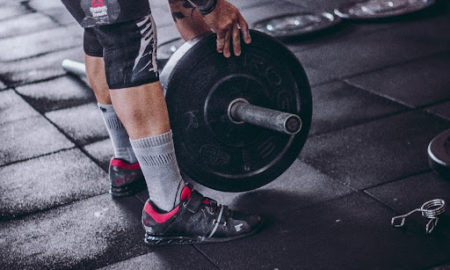Combining strength training with aerobics is a controversial topic for exercise scientists. The point of including aerobics in your strength-training program is to lose fat and improve cardiovascular fitness and stamina. While resistance exercise, exemplified by progressive-weight training, is the key to building muscle and strength, contrary to popular belief, it’s not an efficient way to condition the cardiovascular system or burn fat. Aerobics is far better for that. The controversy lies in the fact that some of the changes produced by the two forms of exercise counteract each other.
For example, while doing aerobics stimulates the development of additional cellular mitochondria, where energy in the form of ATP is produced and where fat is burned, weight training tends to blunt mitochondria development. On the other hand, one reason you grow after lifting weights is that it helps increase muscle protein synthesis—but doing aerobics blunts muscle protein synthesis and tends to slow the release of anabolic hormones, which are vital for building muscle and strength.
More recent research shows that you can get around the problems aerobics creates for strength gains simply by switching to interval-style aerobics. That requires less actual training time yet yields fat-loss and cardiovascular-fitness results similar or superior to what you get from the more traditional steady-state style.
Many bodybuilders overlook the issue of precisely when to do aerobics. Four years ago I reported on a study that found that doing aerobics prior to lifting weights totally blunted the growth hormone release that would normally occur during weight training. I suggested that doing aerobics prior to weight training more or less made the weight workout a waste of time. Subsequent research has modified my view. As it turns out, growth hormone release during exercise doesn’t have such a pronounced anabolic effect in muscle. What counts is the intramuscular release of substances like insulinlike growth factor 1 and mechano growth factor, which are released independently of GH. There are, however, other factors to consider, such as fat burning.
A 2007 study found that lifting weights prior to doing aerobics set up a hormonal environment that encouraged fat burning. Specifically, lifting weights increased the blood concentration of epinephrine, norepinephrine and growth hormone and then reduced insulin. The first three hormones are all associated with increased fat use. Having a lower insulin count also ups fat burning because a high count is known to blunt it.
Taking that into account, a recent study focused on whether performing high- or low-intensity weight workouts prior to aerobic training would lead to greater fat burning during the aerobic session.1 The subjects were 11 men and 21 women who completed three varied exercise sessions:
1) 20 minutes of aerobics only
2) High-intensity weight training followed by 20 minutes of aerobics
3) Low-intensity weight training followed by 20 minutes of aerobics
The training volume was the same for both weight workouts and consisted of six standard upper- and lower-body exercises all done on machines. The only difference was that the high-intensity group averaged three sets of eight reps with a weight equal to 90 percent of eight-rep maximum, while the low-intensity group did the same number of sets but increased the reps to 12 and used a weight equal to 60 percent of eight-rep maximum. The aerobics method was steady-state stationary cycling for 20 minutes at a 50 percent maximum oxygen intake. The subjects started their aerobics five minutes after they finished the weight workout.
They did low-intensity aerobics to avoid producing acidosis, a buildup of metabolic waste products that would hamper fat burning. In addition, doing steady-state aerobics at lower intensity is known to burn more fat. As the intensity increases, the body switches to burning more carbs, such blood glucose and glycogen, which is stored in liver and muscles.
The subjects—both men and women—burned more fat when doing high-intensity weight training prior to aerobics. Maximum oxygen intake was also greater after high-intensity weight training in women and somewhat higher in men. The authors suggest that doing intense weight training before aerobics increases fat release in the blood and sets you up for greater fat burning during the aerobics. One reason is that a higher lifting intensity, in this case involving more weight lifted, brings on the release of the hormones that increase fat use.
One important consideration is the timing of the aerobics after the weight workout. For best results, you should start the aerobics as soon as possible after completing the weight workout. Studies show that waiting two hours obliterates the increased fat oxidation triggered by the weight workout.
Fat-mobilizing hormones revert to their resting state within a relatively short time, which means you should wait no more than 20 minutes between the weight and aerobics sessions if you want maximum fat oxidation. Plus, the weight workout should have a high-intensity design. Lifting light weights won’t lead to the hormone release you need.
Another question regarding cardio is whether aerobics increases resting metabolic rate. That’s the name given to the number of calories your body burns at rest, and it’s considered important for fat loss because it accounts for 60 to 70 percent of daily energy expenditure.
Exercise is considered one of the most efficient methods of manipulating the resting metabolic rate. Thyroid drugs can do that too, as the major function of the thyroid hormones is to control the resting metabolic rate. The drug route, though, has considerable drawbacks. To get a true increase in resting metabolic rate by way of thyroid drugs requires dosages that are above what the body naturally produces. Taking moderate doses doesn’t increase resting metabolism because the body senses the presence of the added thyroid hormone and reduces its own production.
When patients are low on thyroid hormone, doctors often prescribe levothyroxine, which is T4. The active thyroid hormone is T3, and T4 is a pro-hormone that the body can convert into T3 as needed. Again, however, taking the usual doses of thyroid will only correct a deficiency, which would lower resting metabolic rate.
The exercise effects related to resting metabolic rate have varied. Research shows that exercise raises, lowers or has no effect on resting metabolic rate. As to how exercise can raise it, several mechanisms have been proposed, including alterations in thyroid hormone release; increased norepinephrine release; increased protein synthesis, which requires a great many calories; and increased glycogen synthesis after exercise, which is also calorie-intensive.
Just adding muscle through weight training can boost your resting metabolic rate. In fact, the gradual decline in metabolism that is thought to be responsible for the increased fat stores many aging people acquire is often linked to a loss of lean mass with age and inactivity. Confounding those mechanisms is the fact that some people experience elevated resting metabolic rate for no apparent reason. Recent studies, however, suggest that such people have higher-than-usual levels of brown adipose tissue, which provides the potent thermogenic effect of turning calories into heat.
Aerobic exercise, because of its greater intake of oxygen and greater reliance on fat for energy, is often suggested as the best exercise for boosting resting metabolic rate. In fact, that feature is believed to be one of the primary reasons aerobics leads to bodyfat loss. In recent years, however, the idea has been challenged. Indeed, studies that have examined postexercise oxygen consumption, which is a measure of resting metabolic rate, have demonstrated that weight training is superior to most forms of aerobics. That raises a salient question: Does aerobic exercise induce any actual increase in resting metabolism?
A recent investigation of that question lasted 12 weeks and featured two groups of young men, aged 19 to 32, who either 1) didn’t exercise, or 2) jogged or ran for 25 to 40 minutes per session, three to four times a week.2 They trained at an intensity equal to 60 to 80 percent of maximum oxygen intake. The researchers conducting the study tested the men in relation to body composition and various hormones and fatty acids before and after the study.
While the aerobics training induced a significant increase in maximum oxygen intake, the resting metabolic rate didn’t change. Various hormones related to fat loss, such as epinephrine, norepinephrine, total thyroxine, insulin and glucose, also didn’t change. Free thyroxine did decline slightly in the exercising men, but their free fatty acids rose. The resting metabolic rate declined significantly in the men who didn’t exercise, a drop attributed to seasonal variations in resting metabolic rate, which changes with the weather.
Body composition can account for differences in resting metabolism, with leaner and more muscular people showing higher rates, but that wasn’t a factor in the study, for the male subjects all had similar body composition. Despite the lack of changes in fat-mobilizing substances, the free fatty acids in the blood rose in the exercising men. The men also were lower in insulin, which likely accounts for the elevated fatty acids. The authors suggest that the training may have lowered insulin resistance. Also notable was the fact that while resting metabolic rate declined in the nonexercising group, it didn’t in the men who exercised.
So it appears that aerobic exercise does give you increased fat oxidation, does increase oxygen use and may even maintain the resting metabolic rate. What it doesn’t do is increase the resting metabolic rate. Past studies that have recorded that effect have often involved out-of-shape or older people, in whom the resting metabolic rate may be more sensitive to the effects of exercise.
Editor’s note: For information on Jerry Brainum’s new e-book, Natural Anabolics—Nutrients, Compounds and Supplements That Can Accelerate Muscle Growth Without Drugs, visit www.JerryBrainum.com.
References
1 Kang, J., et al. (2009). Effect of preceding resistance exercise on metabolism during subsequent aerobic session. Eur J Appl Physiol. 107(1):43-50.
2 Lee, M.G., et al. (2009). Resting metabolic rate after endurance exercise training. Med Sci Exer Sport. 41:1444-1451. IM
















You must be logged in to post a comment Login